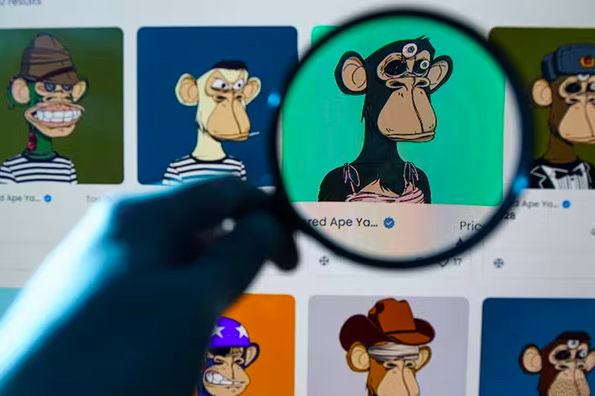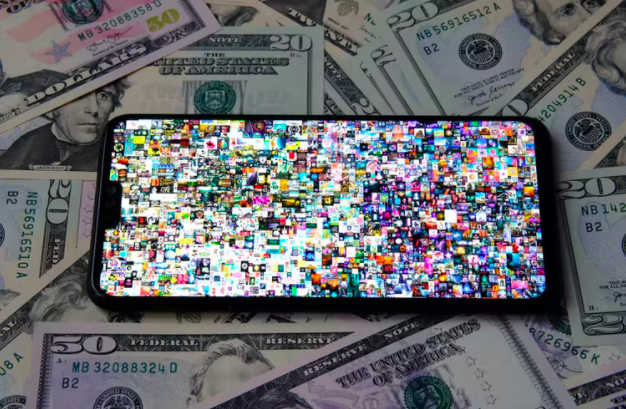One year ago, an artwork was sold for $69 million by the prestigious auction house Christie’s. This was no lost Matisse or rarely seen Van Gogh. Instead, it was a composite collection of digital art by the then relatively unknown artist Beeple.
What makes this piece, Everydays: the First 5000 Days, truly remarkable, is that it was sold as a nonfungible token, or NFT. In the year since that sale, NFTs have gone from a relatively obscure tech-world phenomenon to the mainstream.
NFTs are tokens that exist on a secure record-keeping system called a blockchain. These tokens are akin to certificates of ownership a gallery might give to an art collector, but for digital items.
Celebrities such as Eminem and Jimmy Fallon have helped raise the profile of NFTs through the Bored Ape Yacht Club profile picture collection. These collections have become so popular that Twitter now allows users to use their NFTs as their profile image.
For the collectors, NFTs are arguably a digital extension of benign hobbyist pursuits. In recent generations, collectors may have sought rare Magic The Gathering cards or obscure stamps. Today, those with an impulse to own rare items are attracted to a world where rarity can be transparently recorded and easily verified.
For the creators, NFTs provide a clear path toward monetization. Artists have historically struggled to make money from their work, but NFTs are sold through marketplaces that provide creators with royalties. The Ethereum economy sustained by NFTs earned its creators $3.5 billion in 2021.
The right-click approach
Despite their growing popularity, NFTs still baffle most people. This is because we are not used to the concept of owning digital art. After all, can’t I just right-click and save an image to my own computer? I could, naturally, but this would be to miss the point.
As with all currencies, NFTs have value because of the meaning a community ascribes to them. In the online culture NFTs belong to, “on-chain” blockchain items are meaningful — and some have more value than others.
The characteristic missed by the right-click perspective is that when you own an item on the blockchain, everyone in your community can see this. This can translate into prestige, for example, when outrageously wealthy entrepreneurs bid on rare NFT items, like Beeple’s work or a rare cryptopunk. Or it can simply be a sign to other community members that you belong.
Mainstream attention
Popular attention is not always positive. As NFTs grow, so has the proliferation of cash grabs and scams, especially from social media influencers. Elsewhere I have called this the trash moat that surrounds legitimate projects in the cryptocurrency and NFT world. YouTubers Logan and Jake Paul, in particular, are notorious for their litany of low-quality NFT “rug pulls,” when a crypto project is abandoned by their creators once the money flows in.
Melania Trump, to pick another example, has released several NFT projects. However, blockchain analysts were able to uncover how one of these projects was bought by none other than the creator of the NFT themselves. This practice, known as wash trading, involves NFT creators buying their own works either to save face due to a lack of interest or to generate hype around an influencer or artist and boost the price of the next sale.

Buying an NFT from the Bored Ape Yacht Club collection is like becoming part of an exclusive online club. (Rokas Tenys/Shutterstock via The Conversation)
Yet another capacity of NFTs has emerged in their potential for fundraising. In what started as a meme, ConstitutionDAO was created by a group of cryptocurrency enthusiasts to buy a rare copy of the US constitution that was on auction at Sotheby’s. This group sold a token in exchange for the cryptocurrency Ether that was then used to bid on the constitution. Within a week, ConstitutionDAO raised $47 million. This was not enough to win the auction, but it revealed just how financially powerful this corner of the web has become.
Failure, or the future?
Perhaps the harshest critiques of NFTs come from the socially conscious art world that sees the infrastructure of NFTs as the problem. NFTs mostly exist on the Ethereum blockchain, which relies on vast computational resources to function, generating a huge carbon footprint. Ethereum is transitioning away from its current mechanism to another, which will hopefully alleviate this concern.
Perhaps the more subtle defense of NFTs resides in how they push the medium of digital art in interesting directions. Damien Hirst’s The Currency playfully challenges the collector to choose whether to keep the NFT (the digital token) or exchange it later for a physical artwork. This forces the collector to make a bet on the future: physical or digital, which retains the most value?
This places NFTs in a curious spot. They appear at once a benign hobbyist pursuit, a means to value and make money from scarce digital art, a cash grab for unscrupulous influencers and celebrities, a new mechanism for online fundraising and an explored avenue for legitimate art. However you view them, NFTs have crossed fully into the mainstream and deserve our attention.

This guest post is a part of Web3 Month of Technical.ly's 2022 editorial calendar.
Before you go...
Please consider supporting Technical.ly to keep our independent journalism strong. Unlike most business-focused media outlets, we don’t have a paywall. Instead, we count on your personal and organizational support.
Join our growing Slack community
Join 5,000 tech professionals and entrepreneurs in our community Slack today!





